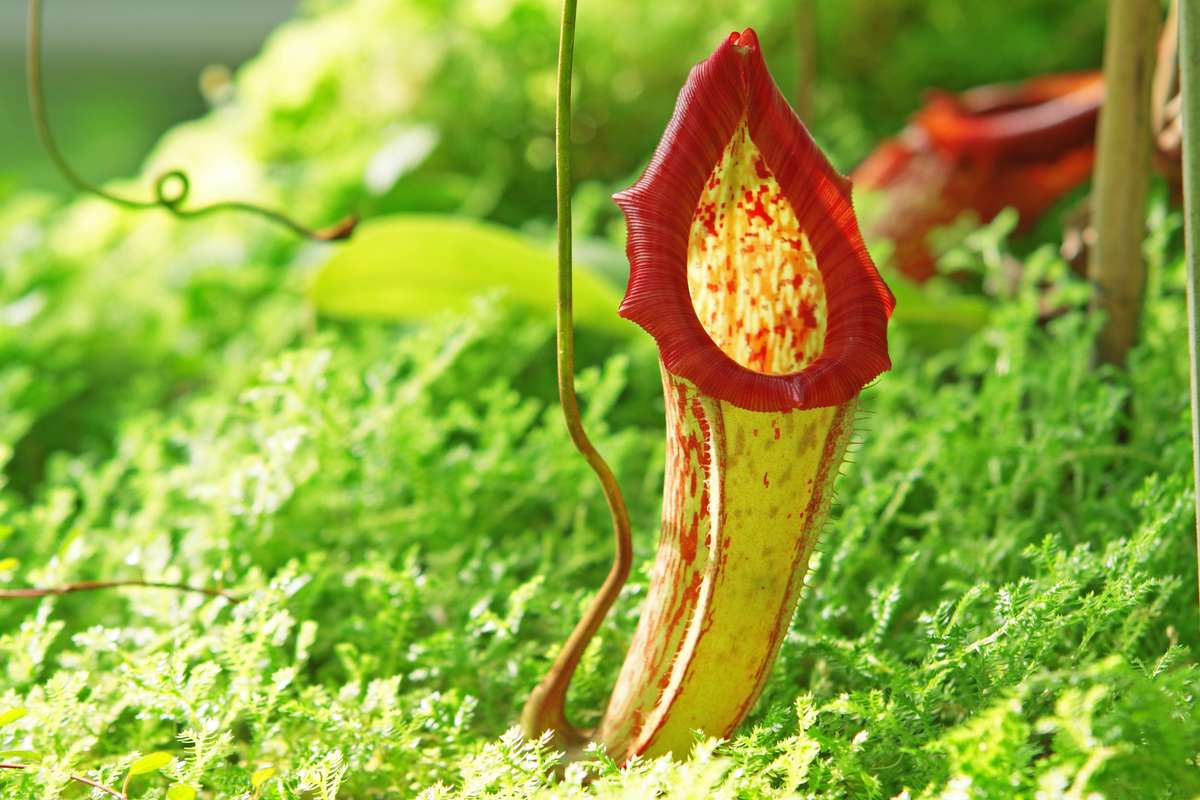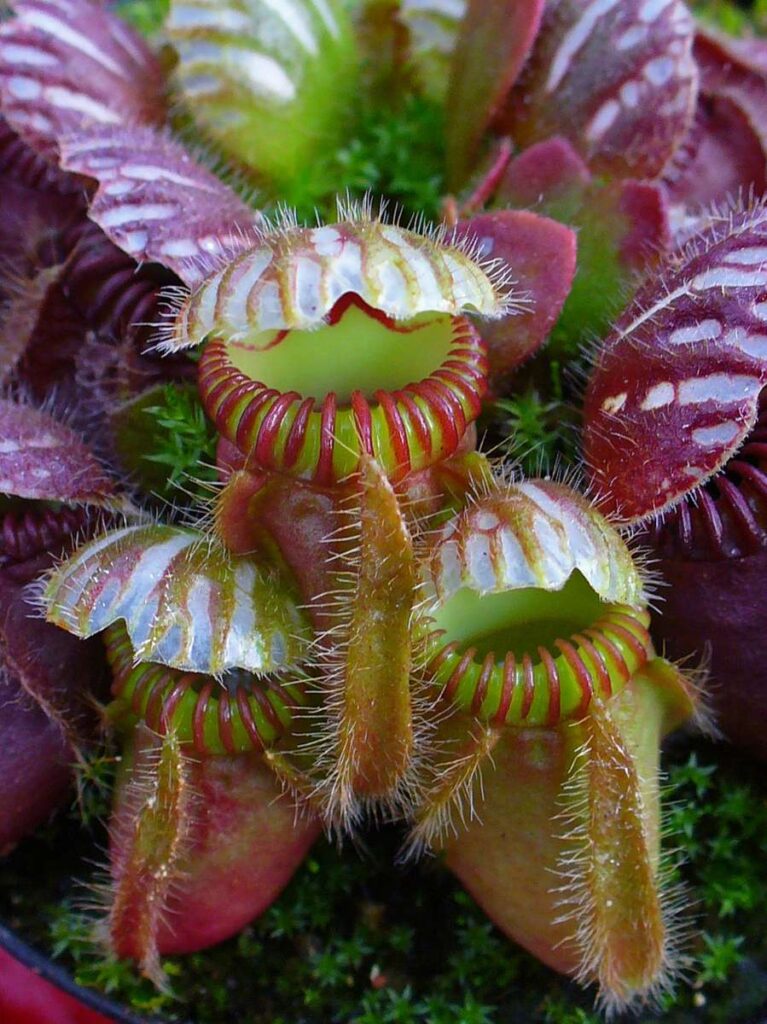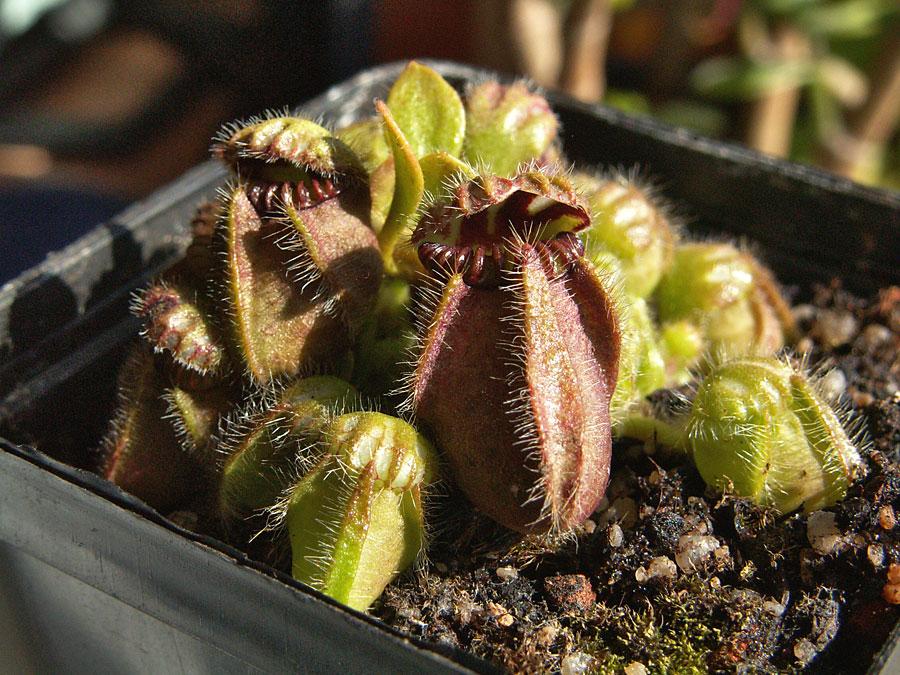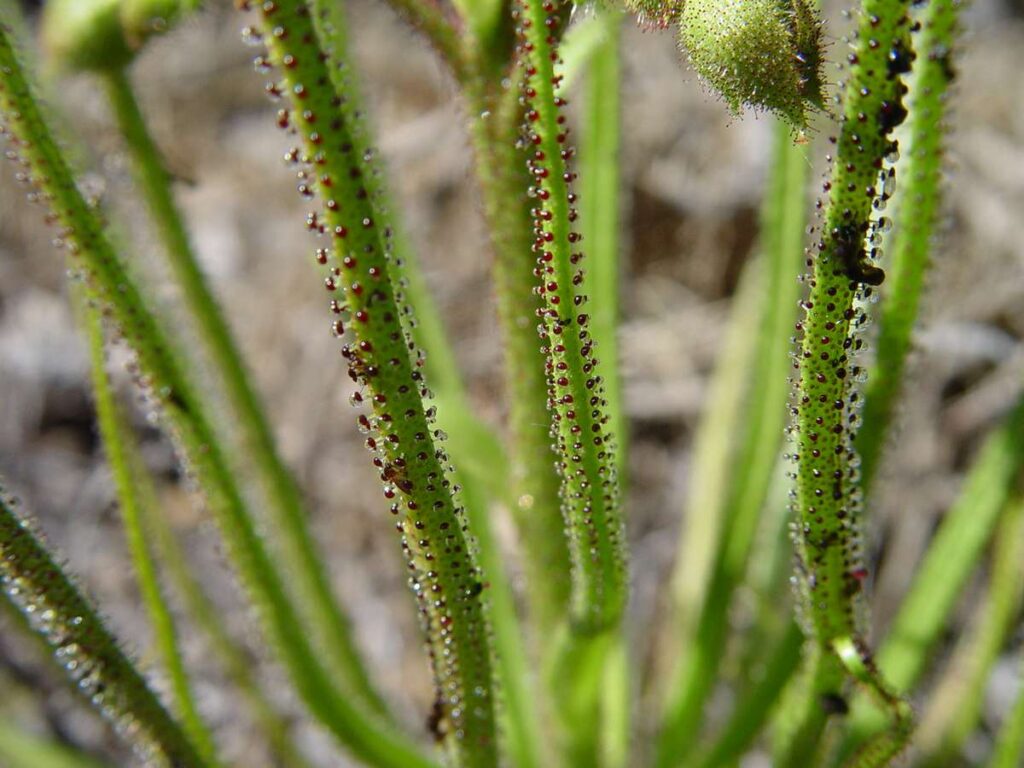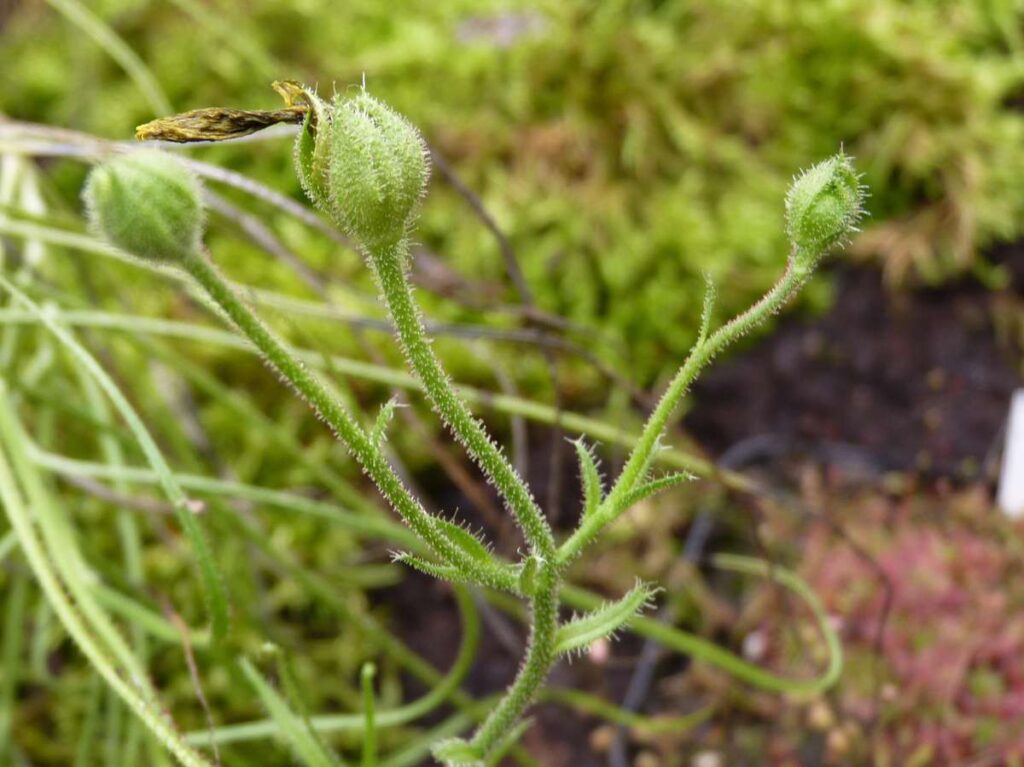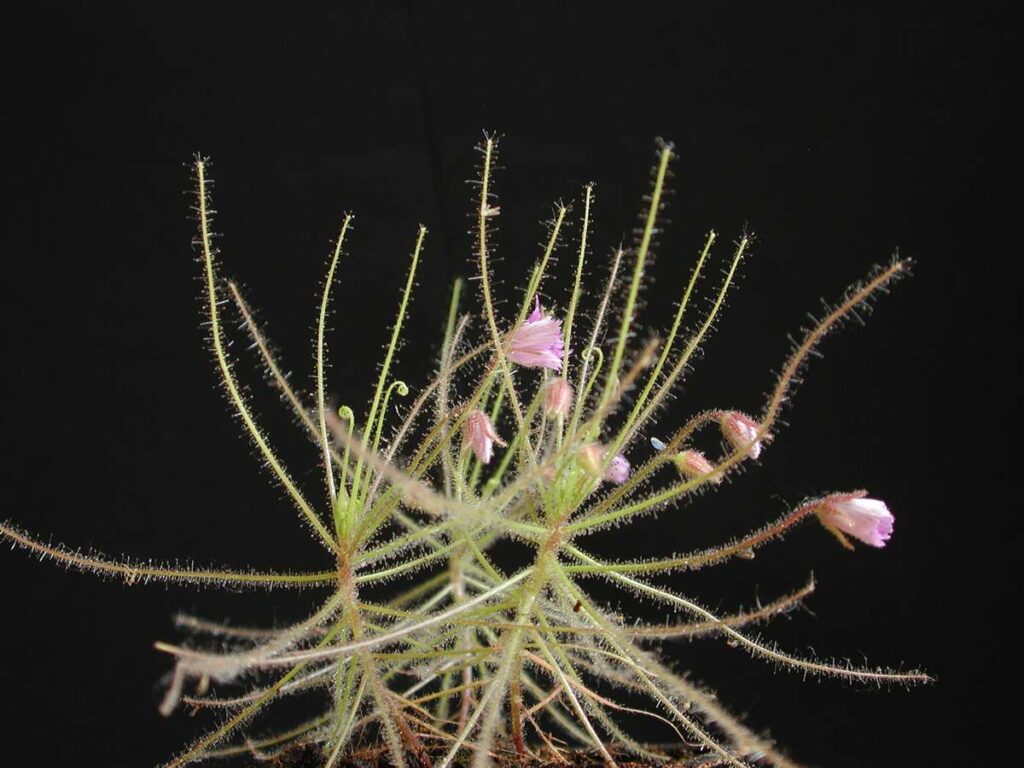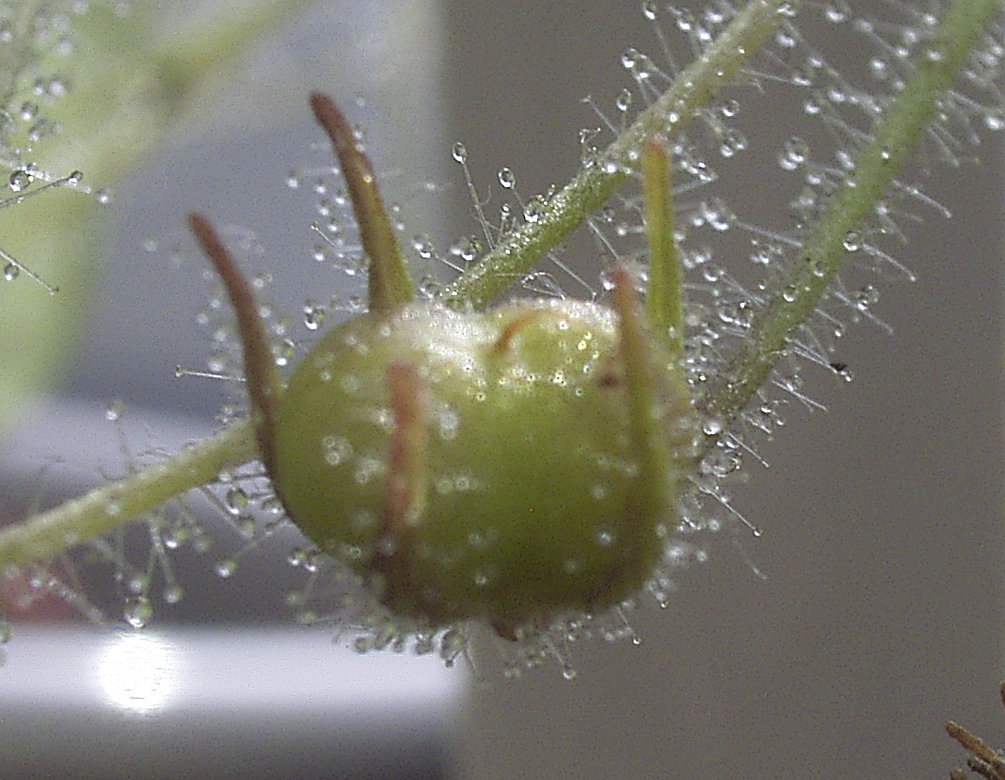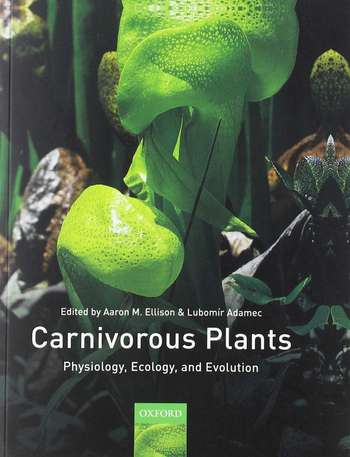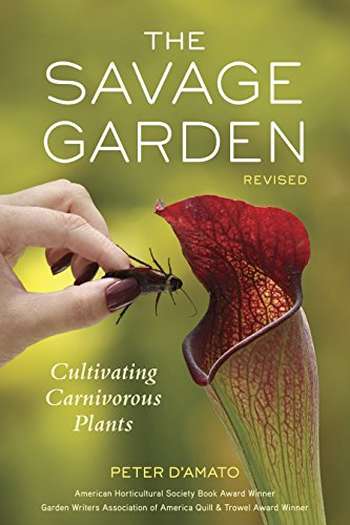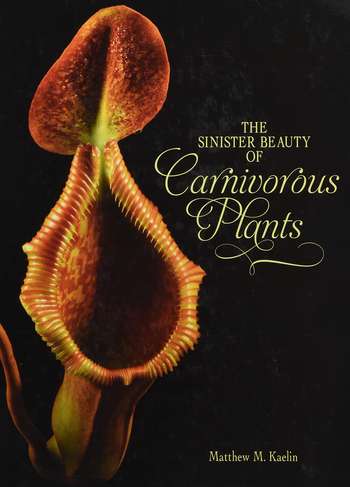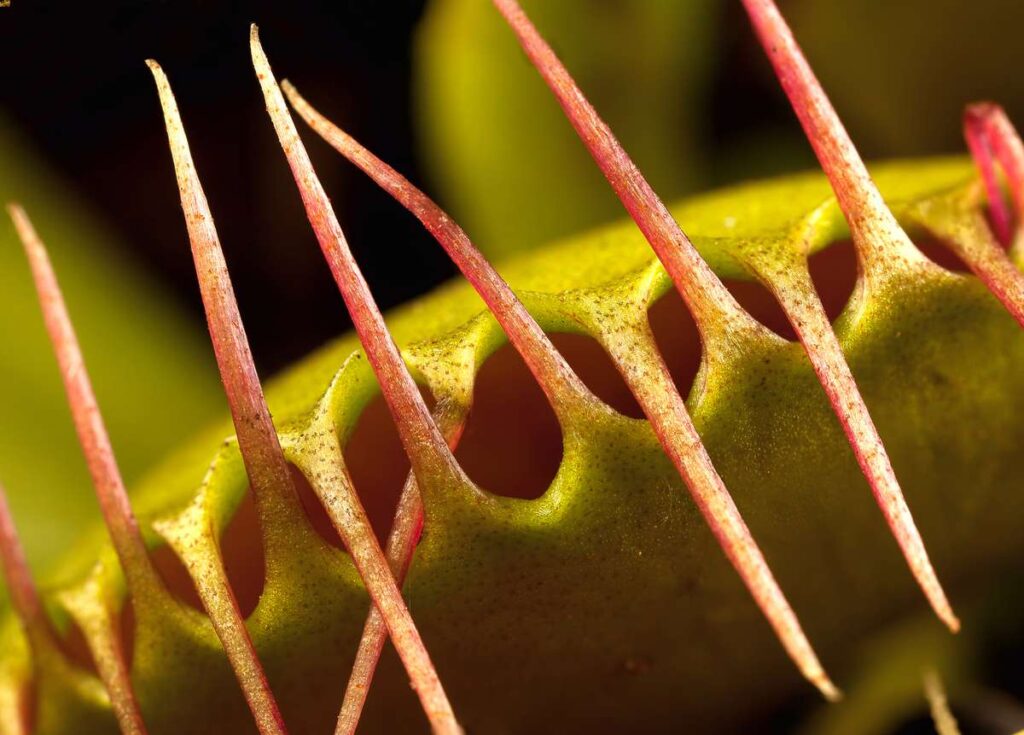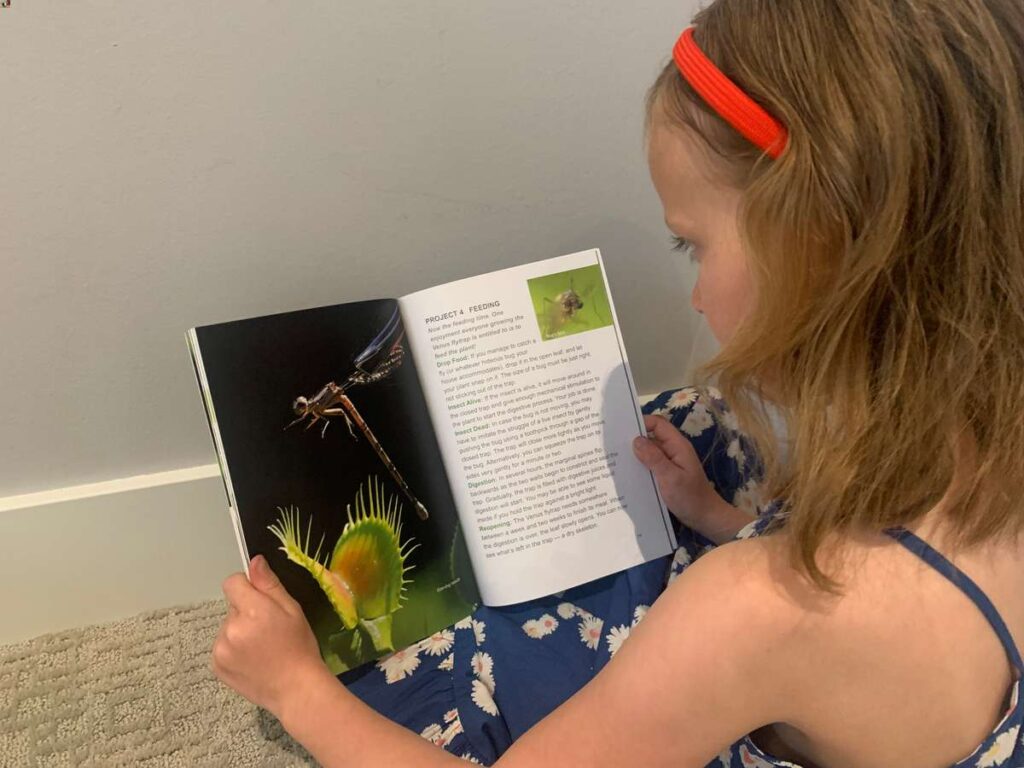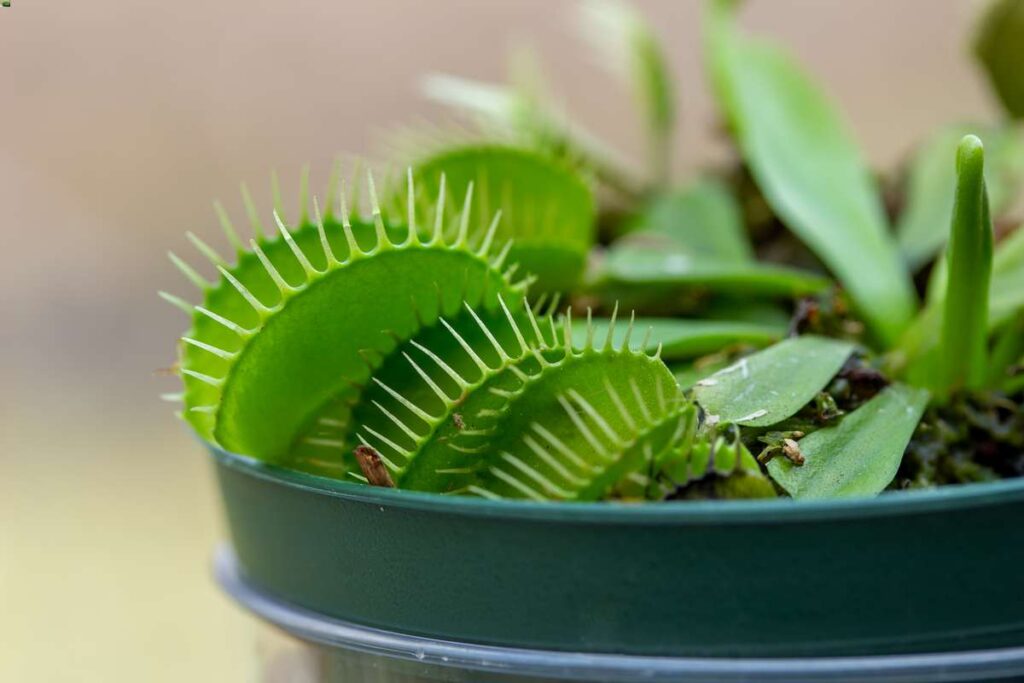Growing up, I lived in a virtual jungle of houseplants, and to this day, the offspring of my mother’s spider plants thrive in all parts of the country. Venus Flytrap was a DJ on a sitcom, and no one ever thought much of insectivorous plants other than screeching eek when some documentary introduced us to those creepy bug-eating plants that left us with a few scary types of carnivorous plants to talk to our friends about.
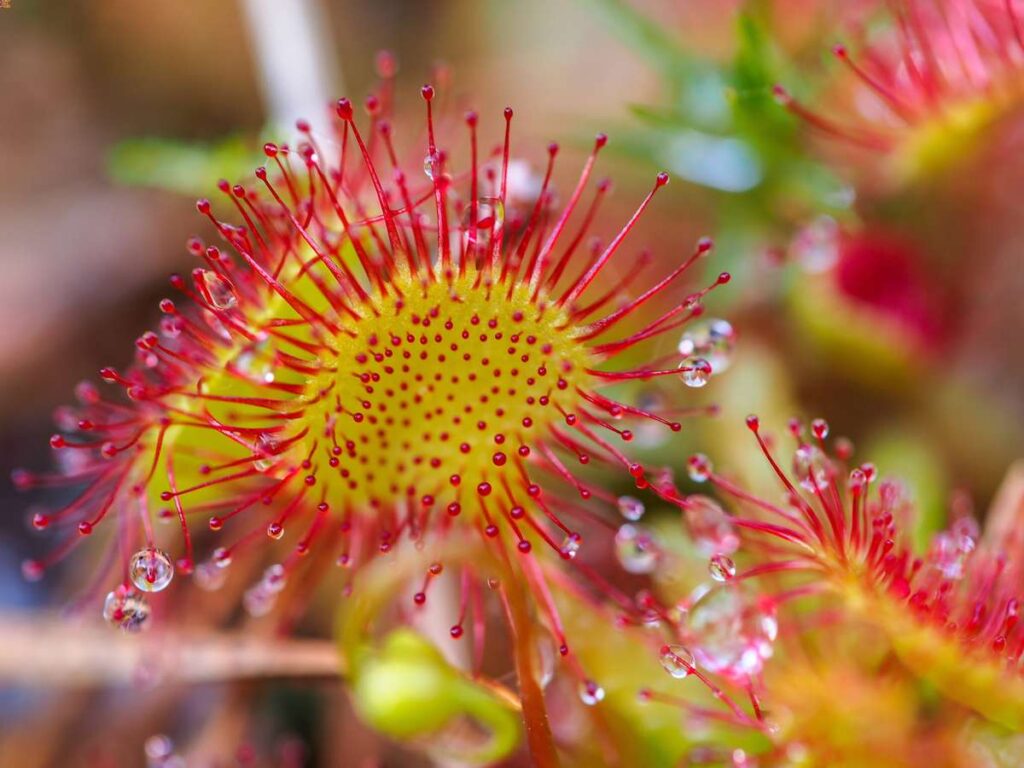
Thinking back on those documentaries, and I am perhaps as old as this iconic carnivorous plant species itself, they didn’t capture how fascinating these types of carnivorous plants really are.
Luckily, we slowly realize how wonderful and fascinating all types of carnivorous plants are, and we’re introducing them to our homes, nurturing them, and appreciating them.
To help you build your bug-eating indoor garden, here is a list of carnivorous plants that will bring joy into your life. And no, at no time will any of these plants entwine you with their foliage and eat you while you sleep.
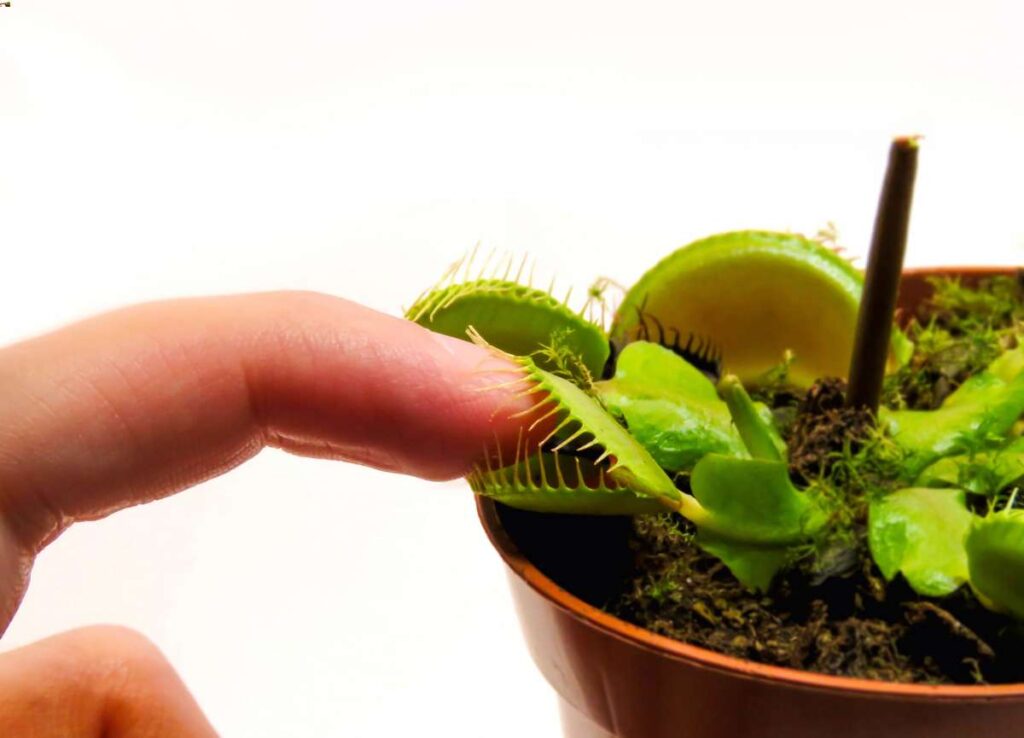
This post contains compensated links.
Understanding the Basic Carnivorous Plant Types
Carnivorous plants are complex plants. But for now, we will split all the types of carnivorous plants into three classifications based on their trap method, how their trap works, and how hungry they are.
These exciting plants have evolved into insect-eaters for many factors; one is their poor soil conditions. To supplement their diet, they munch on a nutritious bug? Yum!
Three Types of Carnivorous Plant Traps
1. Active Traps
This category of carnivorous plants developed specialized traps to capture the insects on their menu. They use real traps to arrest and jail the insects they eat. They snap shut and are sometimes called predatory plants. Venus flytrap and waterwheel (Sarraceniaceae family) are the best known types of insect-eating plants with active traps.
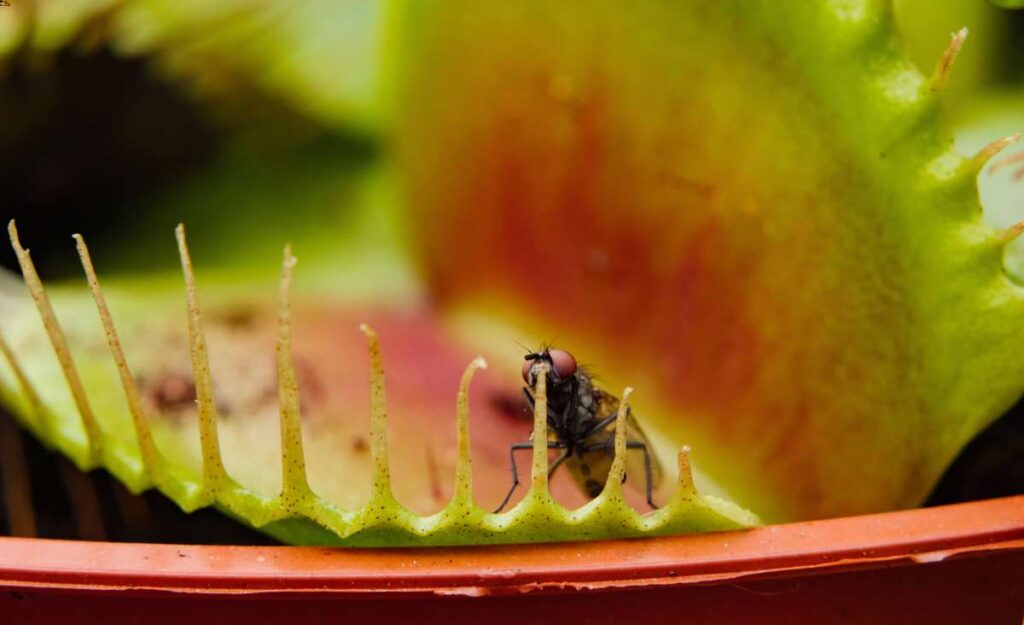
2. Semi-Active Traps
Carnivorous plants in this category use sticky glands on their leaf tops to capture their victims but don’t have a developed trapping system. These bug-eating plants use their leaves which they roll up to keep the insect trapped and start the decomposition process. Think of flypaper with a sticky surface, and butterwort and sundew are common examples of carnivorous plants with a semi-active trap. Think high protein, low-cal snack.
3. Passive Traps
Ingeniously, this category of insect-eating plants uses a lazy approach and its tubular and hollow shape to capture its food source. Not all, but some of these plants with passive traps produce and secrete enzymes that help them digest their prey. California pitcher plant and Sarracenia, which blooms rather prettily, use this method. Open wide; lunch is served.
11 Different Types of Carnivorous Plants
Most of us falsely assumed that carnivorous plants only thrived in tropical, foreign countries. I have news for you, pitcher plants, sundews, bladderworts, and butterworts; oh my, what adorable names, grow on North American landscapes. In fact, the most famous carnivorous plant of them all, the Venus flytrap, grows only in North and South Carolina.
Let’s see what carnivorous grow right in your own backyard:
1. Venus Flytrap (Dionaea Muscipula)
By popular demand, the Venus flytrap fascinates and creeps people out. Its jaw-like trap, with long fangs, snaps shut in under 0.1 seconds. It also has a sensitive awareness to distinguish between living and non-living insects. Trying to trick this plant with a dead fly will only get this response from your houseplant, “I’m so not eating that!”
Venus flytraps also understand the difference between pollinating insects like bees and make an excellent addition of indoor carnivorous plants to your home.
With so many interesting things to know about Venus flytraps, and the fact they exude personality and charm in spades, Dionaea Muscipula are considered by many to be the best carnivorous plants.
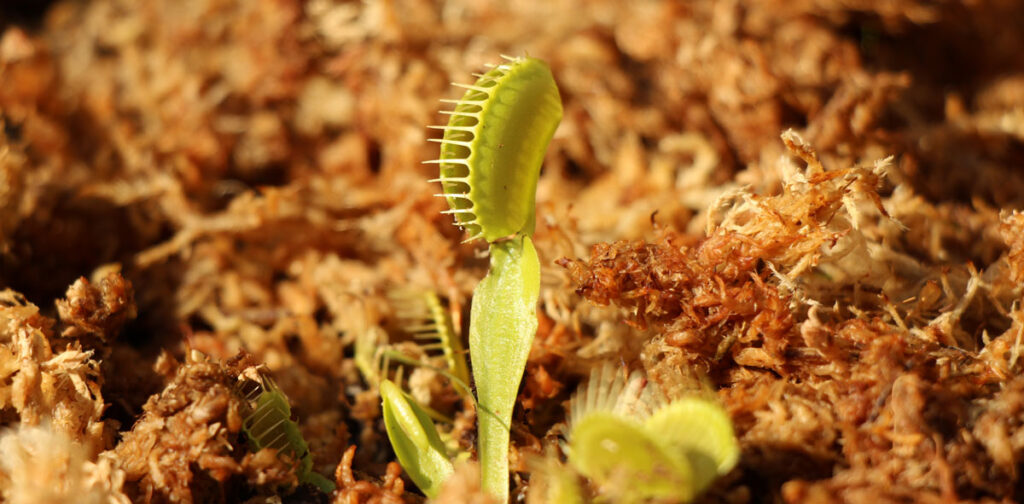
How Venus Flytraps Eat Bugs
Venus flytraps don’t use chopsticks to eat. They snap their jaw shut and start a digestive process by secreting an enzyme that decomposes their food source. Their diet includes flies, ants, crickets, mealworms and uses photosynthesis to munch on when nothing else is available. But they don’t eat meat. That’s just gross.
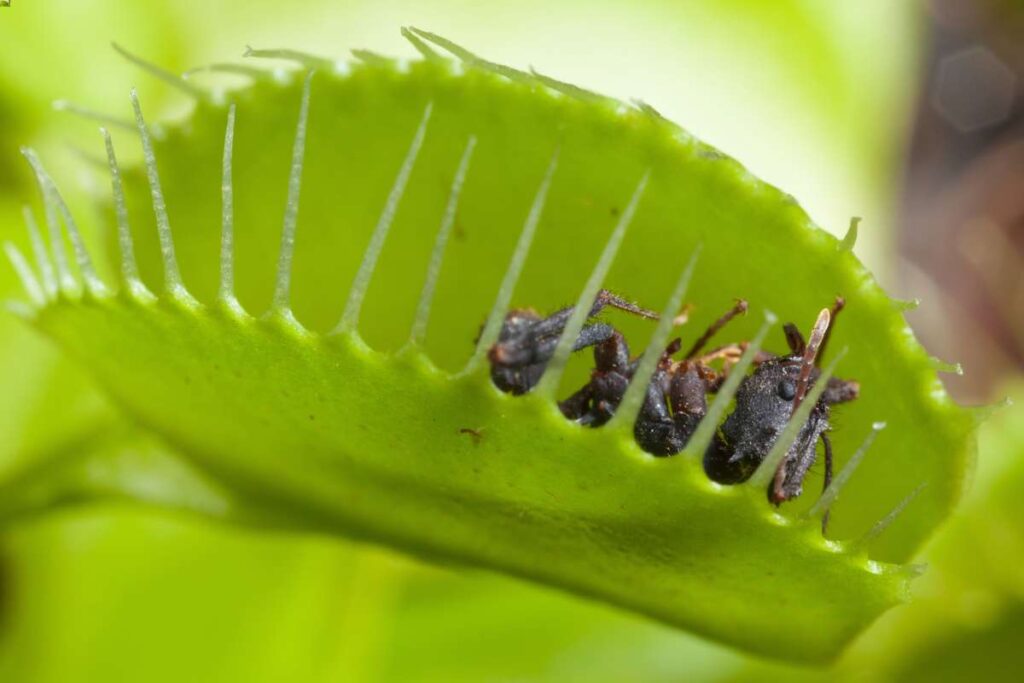
Popular Types of Venus Flytrap Plants
There is only one species of Venus flytrap plants (Dionaea Muscipula), but there are many weird and wonderful cultivars out there which are popular with carnivorous plant enthusiasts. Popular types of Venus flytrap plants:
- The one-and-only original Venus flytrap plant (Dionaea Muscipula)
- Dionaea Dente: short teeth – fierce appearance
- “King Henry” Venus flytrap: one of the biggest flytrap cultivars!

Venus Fly Trap Mugs
Don’t miss this set of fun Venus Fly Trap mugs! Guaranteed to give you a chuckle with your morning coffee!
See on EtsyThe following four carnivorous plants are all types of pitcher plants:
2. American Pitcher Plants (Sarracenia)
The pitcher plant species or Sarracenia is derived from North America and is a cousin to ordinary flowers with a developed penchant for munching on insects. We all have a cousin like that.
Over time, this classification, which has 8-11 species of carnivorous pitcher plants, became very efficient at tricking prey into thinking, ‘oh look at me, I’m just a pretty plant,’ and yes, whamo, done like dinner.
Sarracenia or pitcher plants have a large variety and make ideal houseplants that keep things interesting with their pretty shape, colorful foliage, and stunning flowers. Though pitcher plants also try to avoid pollinator insects, accidents happen, and you gotta eat.
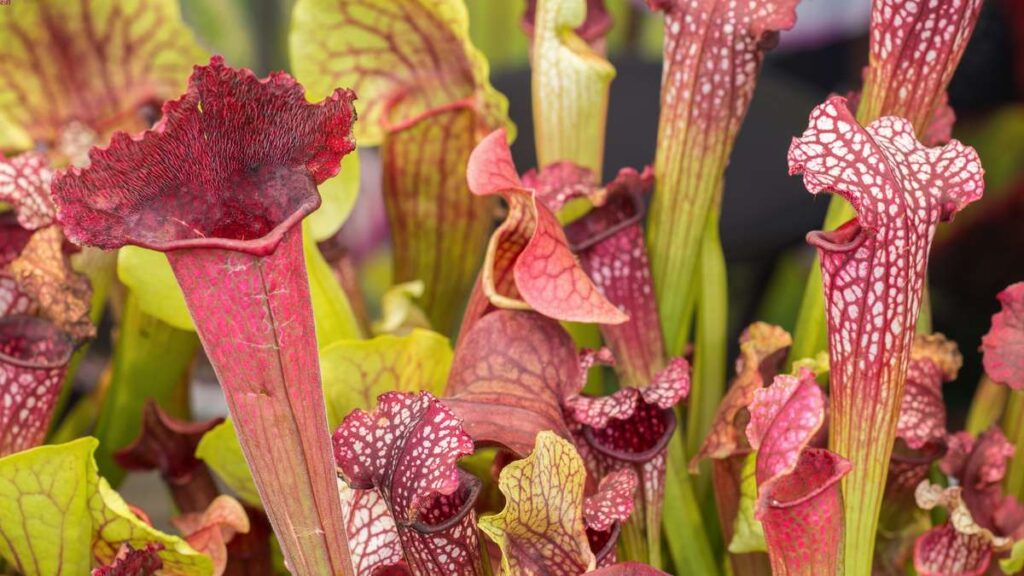
How American Pitcher Plants Eat Insects
One could say Sarracenia plants eat with spoons as these plants rely on their tubular shape and attractive colors to trap and keep their prey. The pitcher’s shape makes it impossible for insects to reach safely, and the water enzymes inside the tube hinder escape. Soups on!
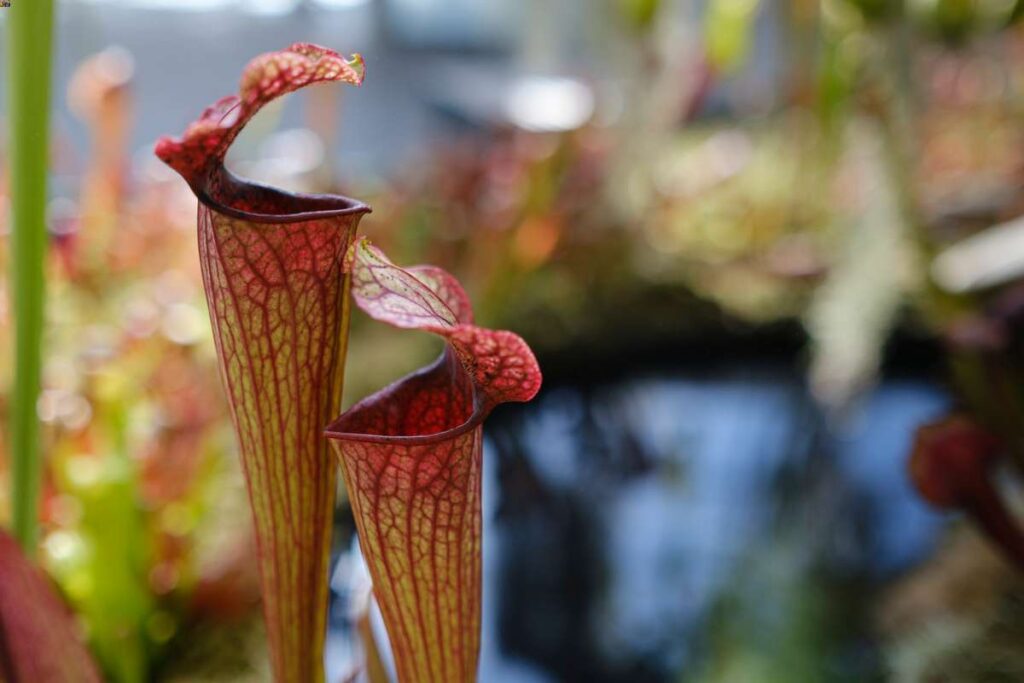
Popular Types of Sarracenia
Two of the most popular types of American Pitcher Plants are:
- Sarracenia purpurea: a compact hybrid trumpet and easy to grow
- Sarracenia leucophylla: White topped pitcher plants with red veining, dark red flowers
3. Sun Pitchers (Heliamphora)
Heliamphora is a relative of Sarracenia from South America. It’s possible to see the family resemblance, and their difference is highlighted merely by where they choose to live. Sun pitchers prefer the highlands of Guiana, where cloud cover and altitude (8,000 ft) provide their ideal wet and boggy environment.
Heliamphora comes from six species and most inherited short stems, but there’s always that anomaly which in this case reaches up to 13 feet and likes to lean on other plants. The curved, often dainty flower bends down to keep rainwater from collecting.
While types of pitcher plants are common throughout the world, five classes are spread across three families. Only one member immigrated to the US; the cobra plant (Darlingtonia) enjoys Northern California and southern Oregon insects served with sauce.
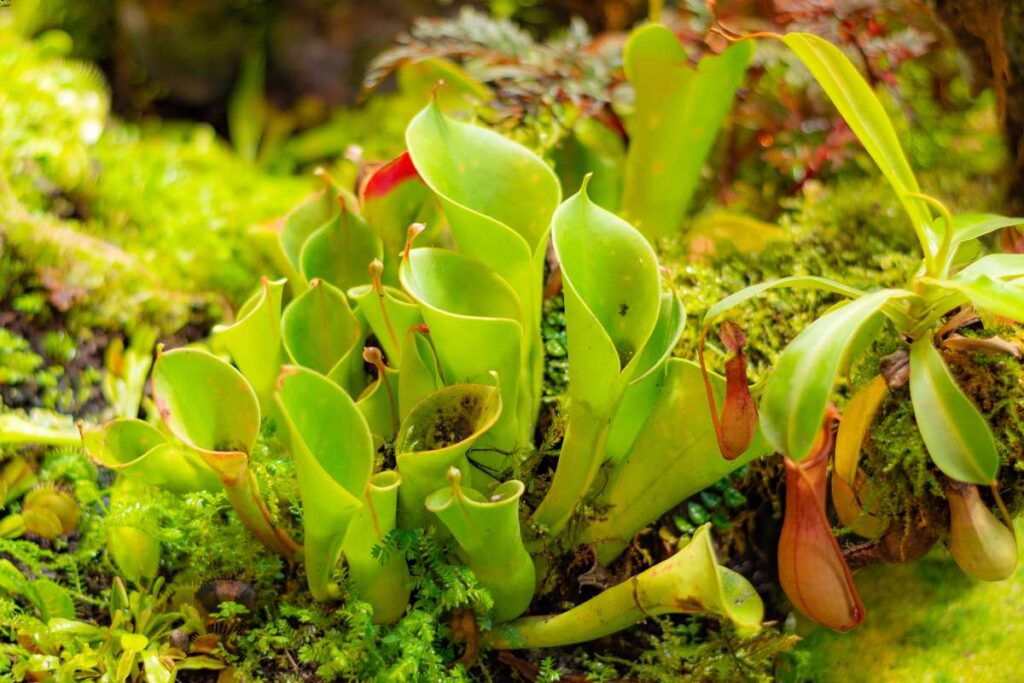
How Sun Pitchers Eat Bugs
The leaves of these pitcher plants play an active role in capturing prey, though they aren’t as efficient. Leaves shape into a hoodlike spoon which saves the nectar from washing away. Growing a bit of beard on the neck tricks insects into walking downward until they go for a refreshing swim in an enzyme bath and become gravy.
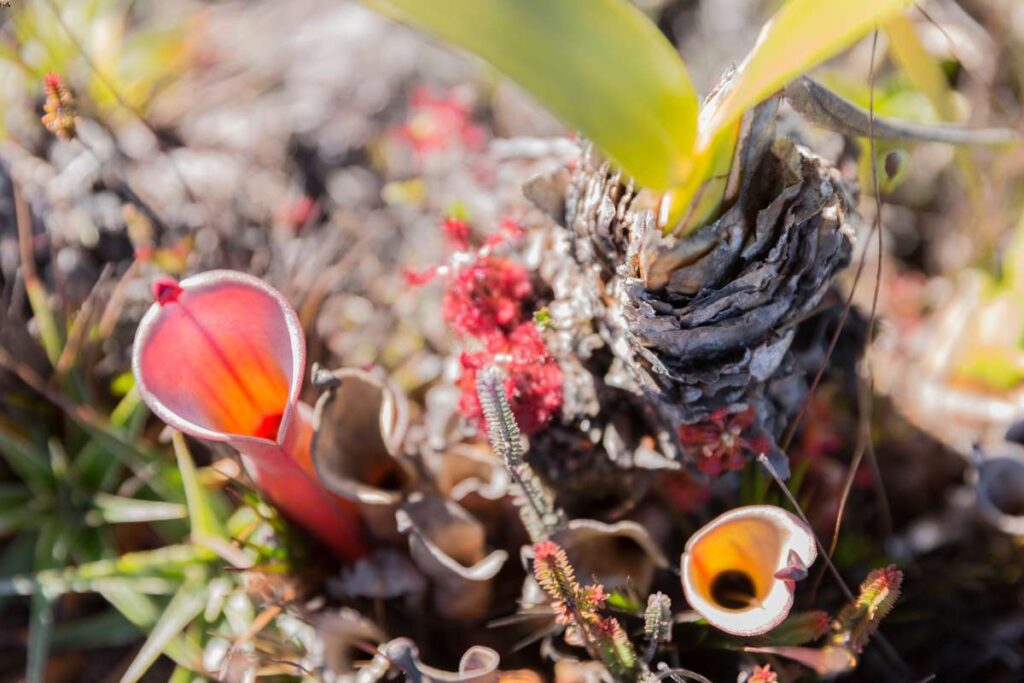
Popular types of Heliamphora
There are many types of Sun Pitcher plants, but the most common type grown by carnivorous plant enthusiasts are hybrids of the Heliamphora heterodoxa. Primarily grown by experienced carnivorous plant gardeners, this Sun Pitcher hybrid is a beautiful species from the tepui of South America.
4. Tropical Pitcher Plants (Nepenthes)
Nephites, sometimes called ‘monkey cups’, are a tropical version of the pitcher plant family. This species developed in tropical regions in Australia, Sri Lanka, and Asia. They brew their own distinct liquid to marinate the insects they enjoy.
Nepenthes are sensitive to movement and start brewing the juice that eventually digests the insects and even small rodents attracted to the scent of their rich aroma. They’re also the biggest carnivorous plant in the plant kingdom.
The nickname monkey cups (or monkey jugs) comes honestly as monkeys often drink from these rain-catching cups that hold up to four cups of water. Amazingly, these pitchers or cups can grow to two feet in size.
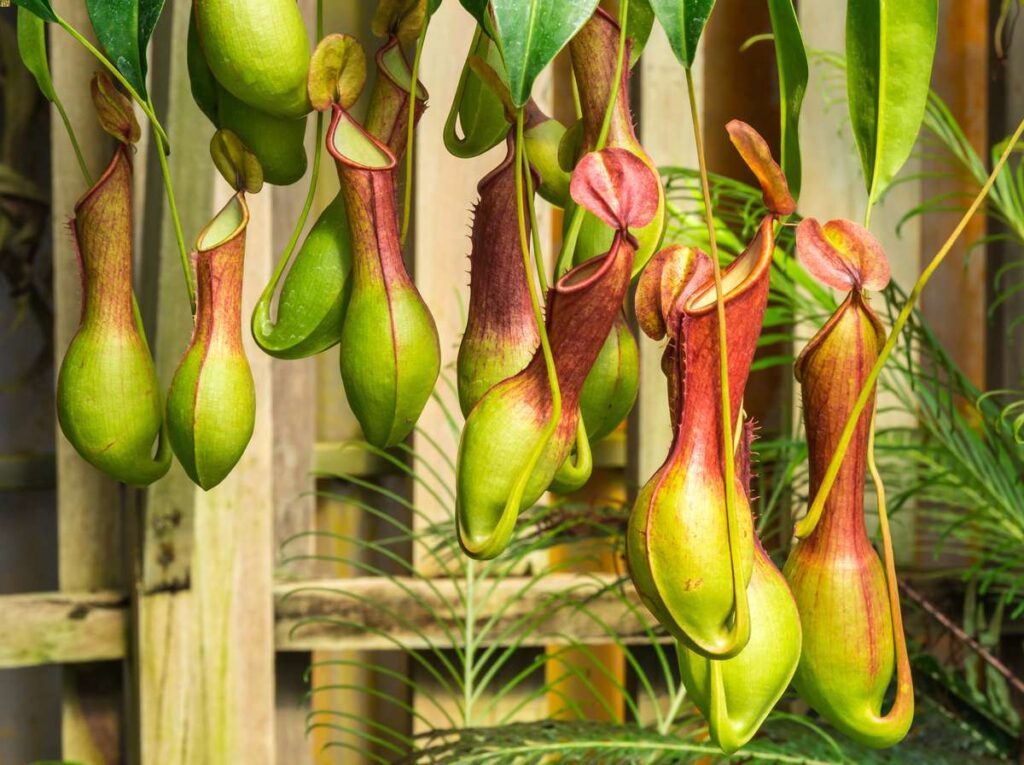
How Tropical Pitcher Plants Eat Insects
Nepenthes never say, “I’ll have fries with that,” they prefer their diet of tropical insects and rodents and produce a potent brew that helps them digest their meal trapped in the pitcher.
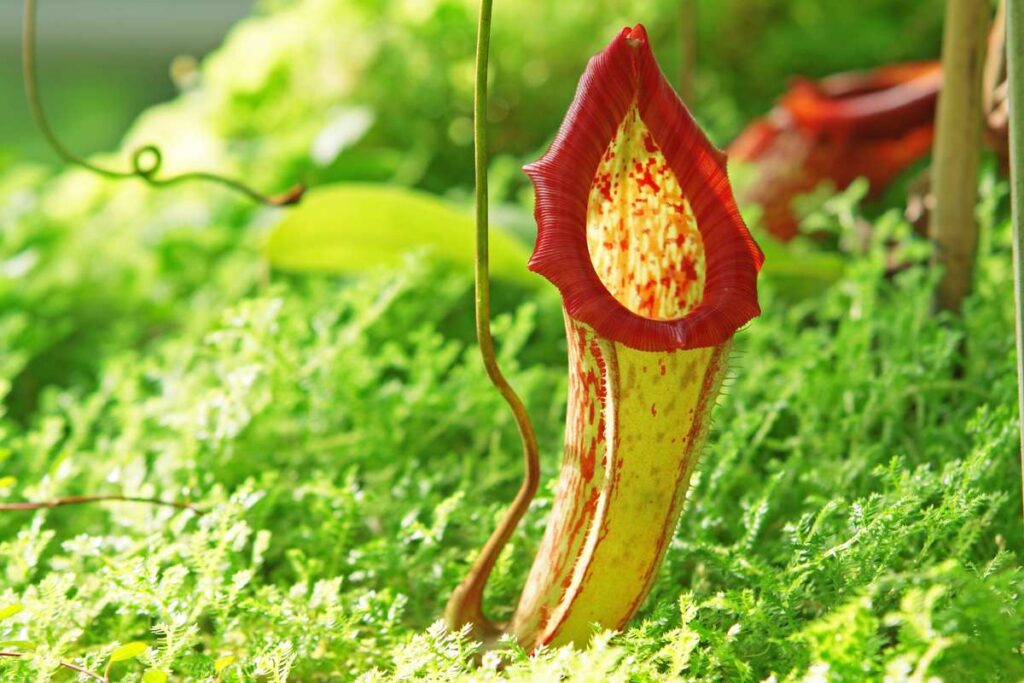
Popular Types of Nepenthes
The most commonly found monkey jugs are the Nepenthes alata, a tropical pitcher plant endemic to the Philippines known to be good for beginners.
5. West Australian Pitcher Plant (Cephalotus follicularis)
The Western Australian pitcher plant perhaps looks most like the infamous Venus flytrap.
Endearingly called fly-catcher plant, Albany pitcher plant, or Australian pitcher plant, this plant also defines what carnivorous plants are. Native to damp, swampy, and sandy landscapes, this species flowers with the most delicate blooms and makes an attractive carnivorous house plant.
When an Aussie pitcher plant consumes insects, it gathers nitrogen and other nutrients lacking in the soil. In its natural state, this carnivorous plant is considered vulnerable. However, collectors enjoy this plant, and it is now grown through seeds and cuttings rather than by violently transplanting it from nature.
How a West Australian Pitcher Plant Eats Bugs
The Aussie pitcher is a chameleon that bears traditional leaves and pitfall traps for insects and other prey, excluding koalas because they’re just too cute. Trap leaves form short pitchers with a hair red and white umbrella lid to keep the rain out.
The West Australian Pitcher Plant produces yummy nectar that insects can’t resist. Inside the pitcher, two taps, or glands, produce a liquid digestive enzyme. They prefer ants but aren’t averse to snacking on other visiting insects.
Popular Types of Cephalotus Follicularis
The Australian Pitcher Plant is the only one in its genus, but cultivators have success producing variations. Like many types of carnivorous plants, this insectivorous plant is rare in the wild and should only be grown from seed and/or purchased from reputable dealers.
6. Sundews (Drosera)
Replicating the sun’s rays with its hairy leaf patterns sprinkled with dew, sundews are aptly named carnivorous plants. But the plant is neither the sun nor is the dew a liquid coating. You guessed it; it’s a sticky substance that attracts insects out minding their own business when voila, they’re lunch.
Sundews paint a pretty picture on swampy and beachy locations, and only about 200 types of Drosera are cataloged. Some sundews are tiny and others significant, like bushes.
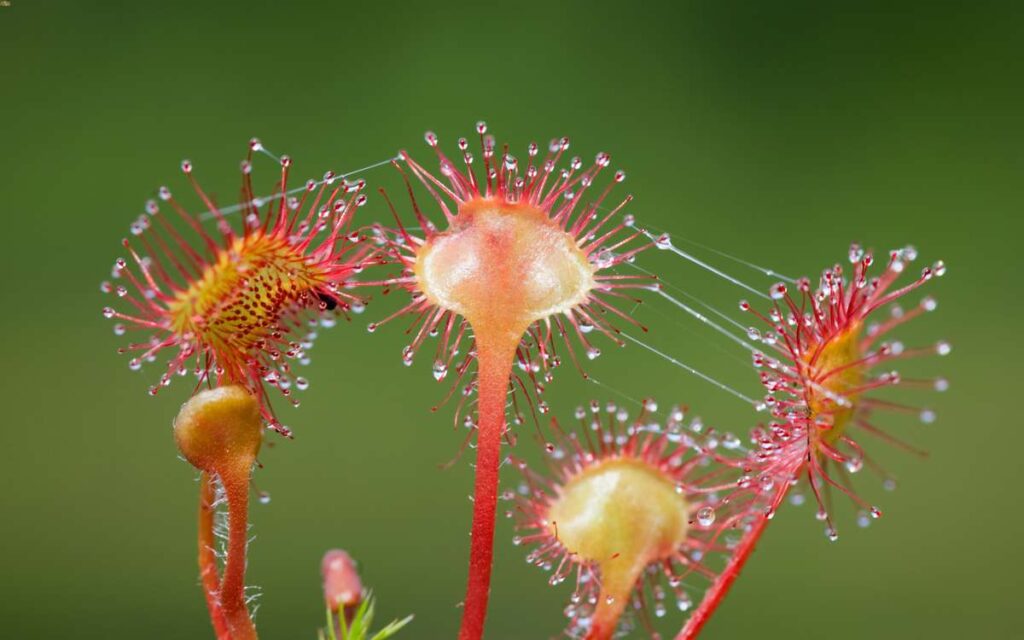
How Sundews Eat Insects
The hairs on sundews are trichomes that fasten the passing insect to the plant and help digest it with a unique dewy enzyme.
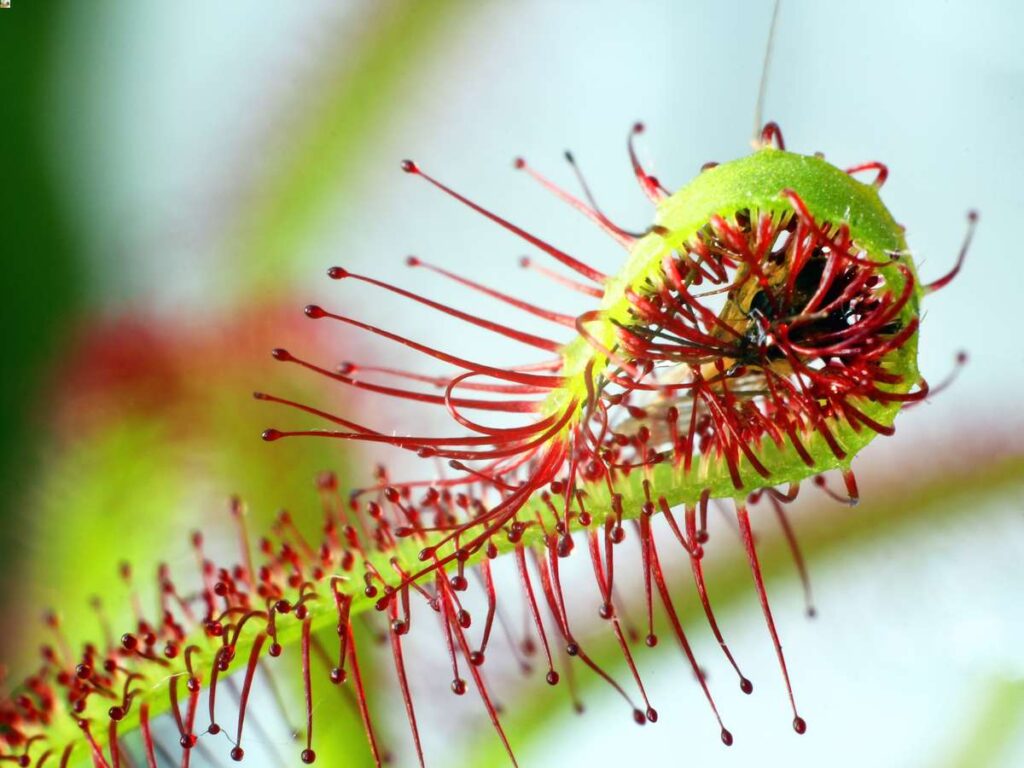
Popular Types of Drosera
There are many types of sundew plants for carnivorous plant enthusiasts:
- Drosera Spatula – a small rosette-forming carnivorous sundew plant with red traps and lots of tentacles
- Drosera capensis – a perfect starter carnivorous plant which grows quickly
- Drosera rotundifolia (round-leaved sundew)
Fun Fact about Drosera
According to Wikipedia, Charles Darwin once Darwin wrote, “…at the present moment, I care more about Drosera than the origin of all the species in the world.” Although many people believe Charles Darwin’s book Insectivorous Plants was focused on the Venus flytrap plant, it was actually more focused on the Drosera sundew plant.
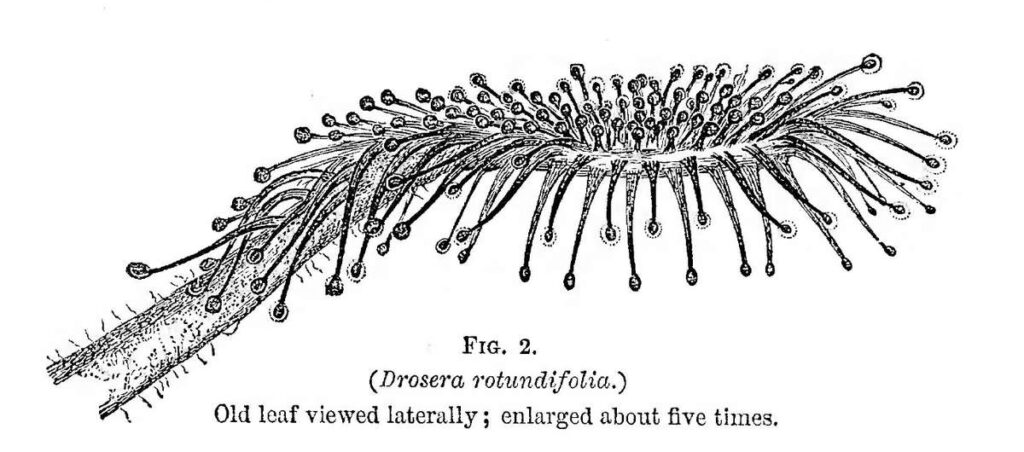
7. The Butterworts (Pinguicula)
Never let the size fool you. These dainty and bright flowers have learned a trick or two by watching the Drosera’s method of attracting and catching prey. Covered in sticky hairs, the Pinguicula leaves trap the insects, making this plant an expert sticky carnivorous plant. Escape is futile.
Known as the little greasy one, this tiny carnivorous plant survives anywhere from Siberia to Central and South America. What’s enchanting about these pretty flowers is that no one would suspect them of eating insects, including visiting insects.
Although the vibrant blooms are short-lived, the plant behaves similar to a succulent and becomes dormant and goes on a diet.
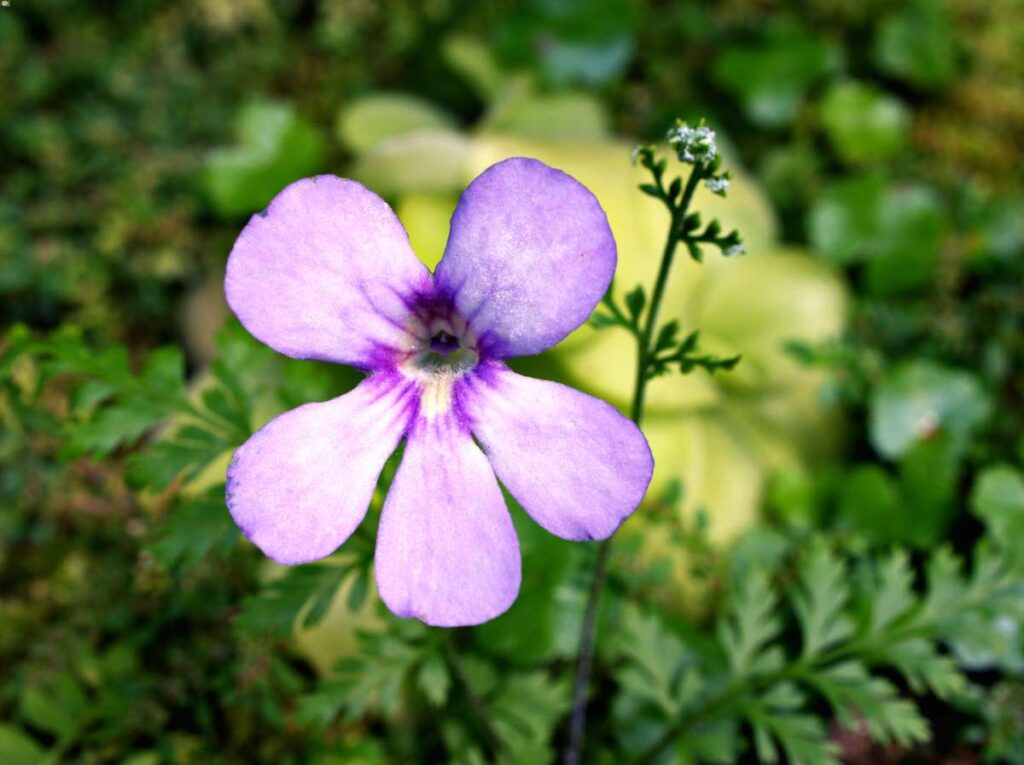
How Butterworts Eat Bugs
The sticky leaves of a butterwort plant trap their lunch and dissolve it into a delicious and usable nutrient. It’s a simple and effective method.
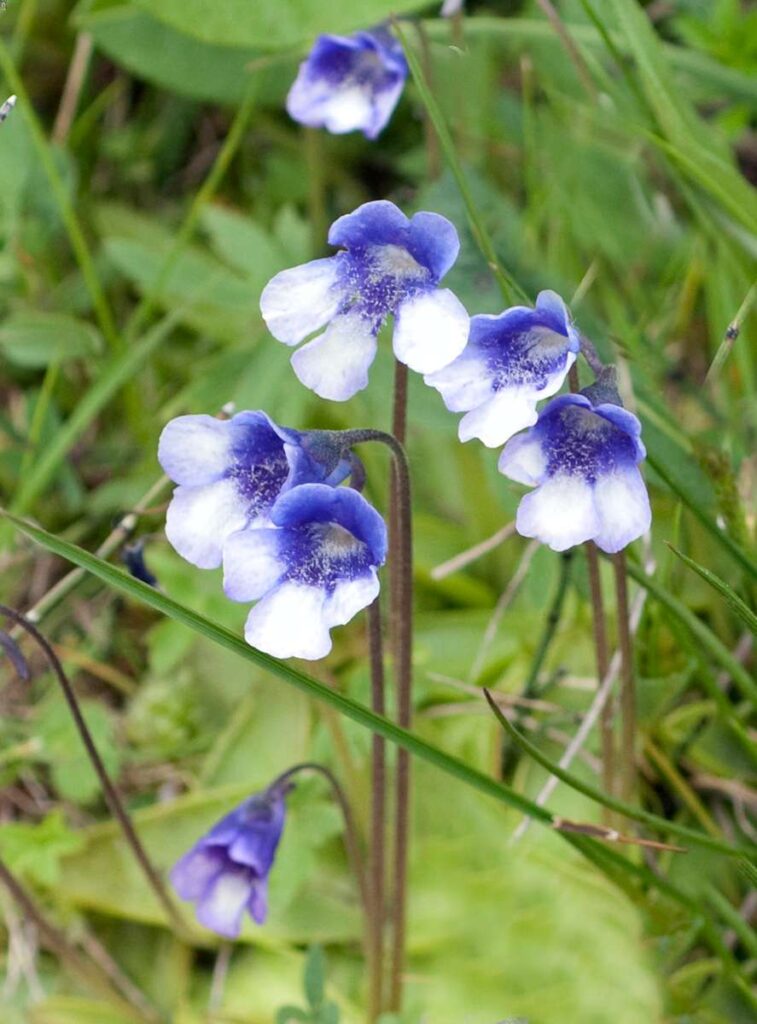
Popular Types of Pinguicula
With such pretty flowers, butterworts are among the popular types of carnivorous plants people love to cultivate. There are many different species of butterwort available for purchase, including the common Pinguicula vulgaris.
8. The Bladderworts (Utricularia)
Bladderworts like water and thrive around rivers and lakes. Lacking roots, bladderworts rely on floating stems and suck insects through a straw-like process. You do what you gotta do to survive.
Bladderworts come from a large genus of about 220 plants that rely on hollow sacs to capture and digest tiny animals. Utricularia are not picky eaters and enjoy a diet of aquatic worms, water fleas, and insect larvae hatching in waterlogged soils.
Bladderworts have gone forth and multiplied, and several species have become invasive. Studies suggest that this genus of carnivorous plants forms relationships with microorganisms, possibly to aid in the attraction and enzymatic digestion of prey. It’s a win-win situation.
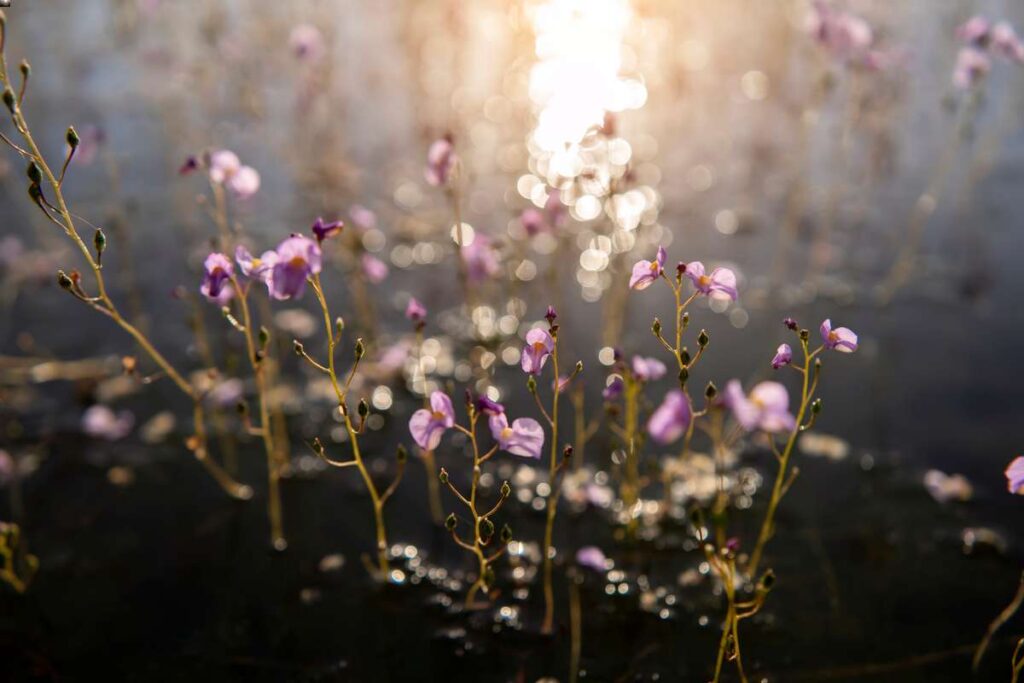
How Bladderworts Eats Insects
Bladderworts developed hollow underwater sacs with valves that open and shut. Water moves through the bladders, and if an insect swims by, the trap door opens and sucks the insect inside in a lightning-speed process. Highly efficient, the trap is set again after about 15 to 30 minutes. Some are slow eaters, others scarf.
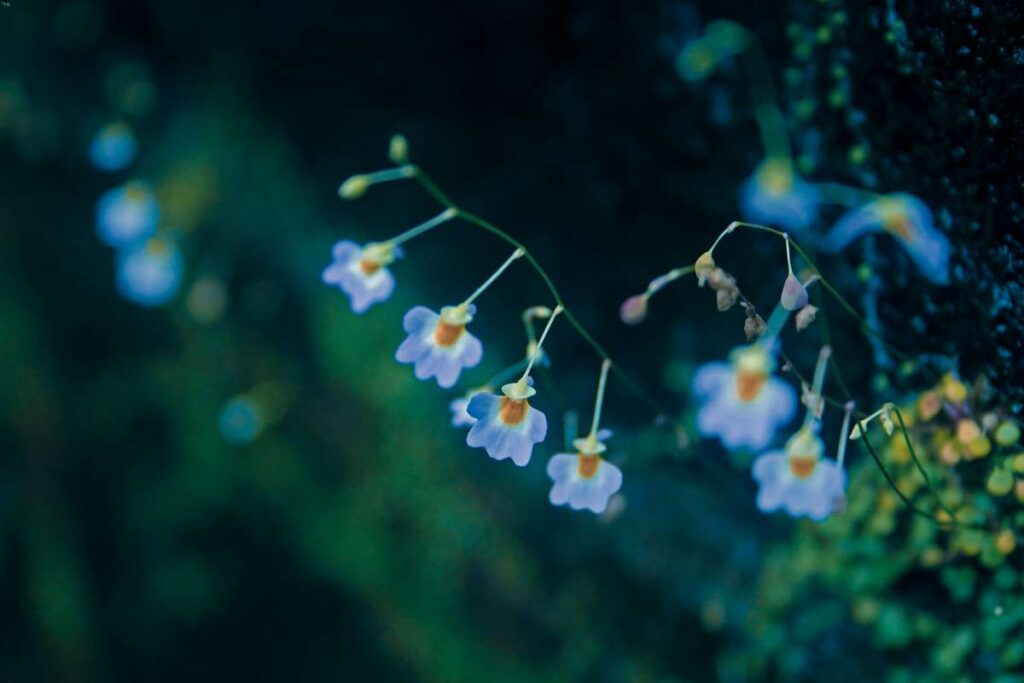
Popular types of Utricularia
With a wide variety of beautiful Butterwort carnivorous plant species, there are plenty of Utricularia plants for enthusiasts to choose from, including Florida purple bladderwort, golden bladderwort and swollen bladderwort.
9. Cobra Plants (Darlingtonia californica)
Native to California and Oregon, cobra plants enjoy swampy and mountain terrain. Though cobras have fragile roots, they are so advanced that they survive wildfires and regrow. It plays among the big boys in the redwood forest and doesn’t mind higher altitudes with moderate climates.
Classified as a passive trap plant, the tubular leaves on a cobra plant form a deep sac with a small opening. Its nickname cobra stems from its unique similarity to a cobra in an aggressive stance. What’s super cool is that the cobra plant has learned to remove excess water from its pitcher.
A cobra grows into a tall plant with a hooded pitcher-like leaf, and it entices passing insects with its nectar. Bugs simply never learn.
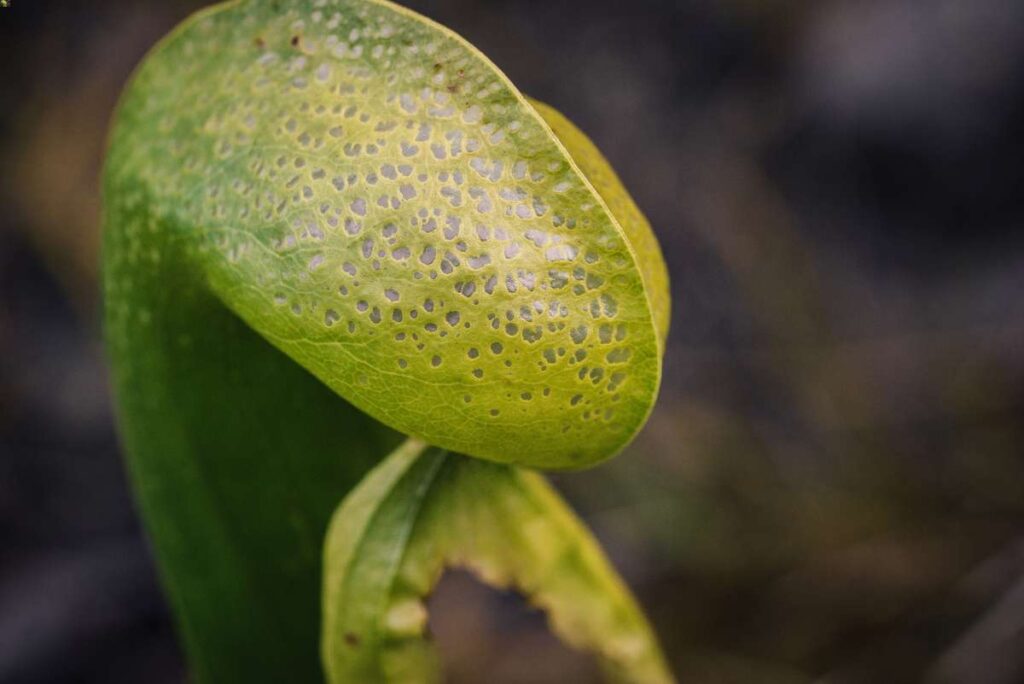
How Cobra Plants Eat Bugs
Once a cobra plant has the attention of an insect, the tongue acts like a ramp, and like every horror movie, the unsuspecting insect follows the path downward. Once inside, it’s game over, and the bug falls into the fluid at the bottom of the cobra plant. Sink or swim, the insect is reduced into a slushy by bacteria and not enzymes. A plant’s gotta eat.
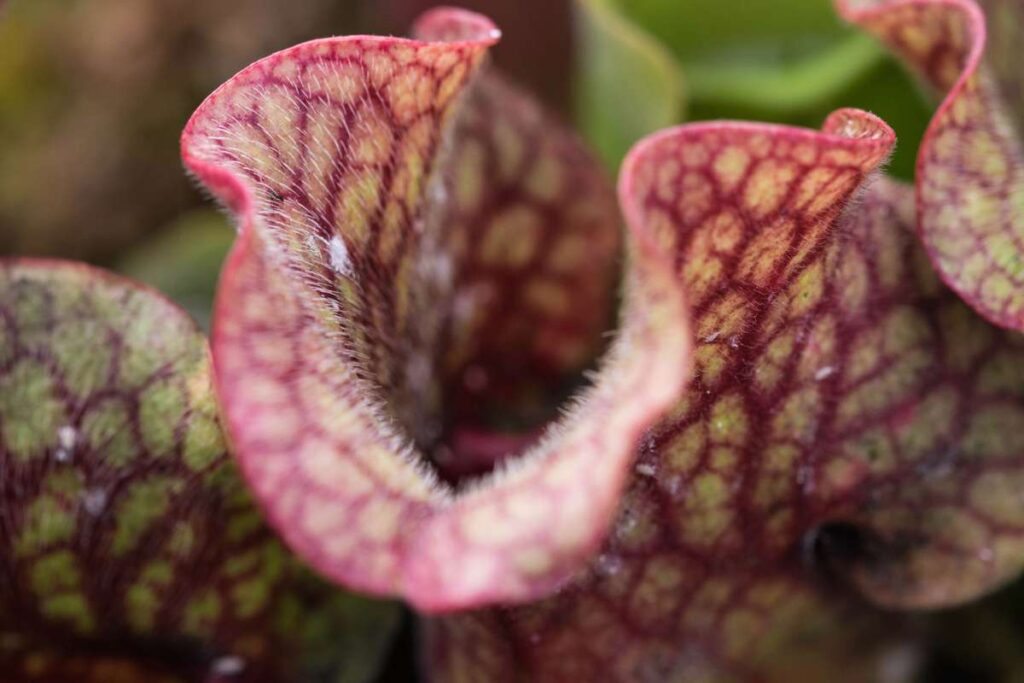
Popular Types of Darlingtonia californica
As the only species of its genus, the Darlingtonia californica goes by the names of cobra plant, cobra lily and also California pitcher plant.
10. The Dewy Pine (Drosophyllum lusitanicum)
Dewy Pines are precisely like the picture your mind forms when you hear their name. But there are differences. The dewy pine mimics pine needles and instead relies on its carnivorous leaves to do all the talking with its sweet-smelling dew.
Though they don’t look alike, these pines are more closely related to Tropical Pitcher Plants (Nepenthes).
How the Dewy Pine Eats Insects
Here’s the trick. The dew drops detach from the Dewy Pine plant when the insect passes through or over them. Really one of a kind, this amazing carnivorous plant secretes dew that magnifies the red color of its gland. As the insect tries to get the sticky substance off, it tangles with more glands that cover its body entirely like a chocolate bonbon and suffocate it.
Popular Types of Drosophyllum lusitanicum
Sometimes called the Portuguese sundew, the dewy pine carnivorous plant is one of a kind.
11. The Rainbow Plants (Byblis)
If you think the rainbow plant is a sundew, you’re not the only one confused. With a pretty and dainty flower and leaves that shine in the sun, rainbow pants are closely related to butterworts and use a similar digestive gland and flower shape.
Rainbow plants eat pollinators, but hey, it’s designed like that. The plant produces long stems and furry branches like tentacles and ensnares landing insects.
Byblis is named a rainbow plant because each species produces a different color, just like a rainbow. They are suspected of working in cahoots with assassin bugs that are not affected by the sticky mass. Eventually, after a big feast, the assassin bug poops, and that’s like dessert for the byblis. Oh, joy!
How Rainbow Plants Eat Insects
The hairy leaves of a rainbow plant secret a tantalizing glue mixture from two glands that insects find irresistible. Once the insect realizes this glue isn’t much fun, they struggle and eventually die from exhaustion or suffocation. The second gland activates and produces the digestive juices to dissolve the insect’s tissues.
Popular types
Byblis Aquatica, filifolia, and gigantea are some of the common types of rainbow plant.
Types of Carnivorous Plants – Conclusion
I hope you enjoyed this journey to discover more about the types of insectivorous plants on our planet. Like animals, plants contribute to our well-being and make Planet Earth so unique. No wonder we have visitors from outer space.
Studies on plants and plant behavior teach us so much if we choose to listen. Plants bring us joy, refresh the air we breathe and even deal with the pesky bugs.
Consider adding different types of carnivorous plants to your indoor garden and learn how complex and unique they truly are.

